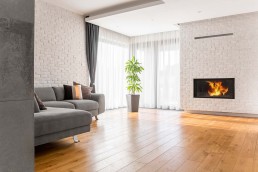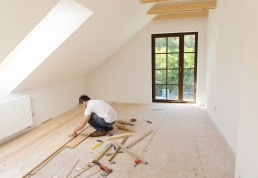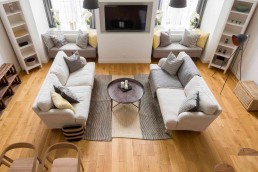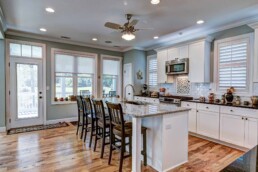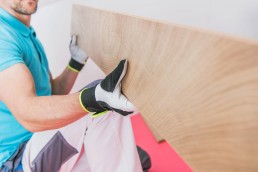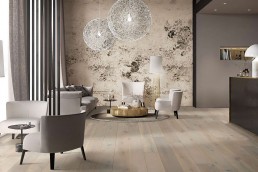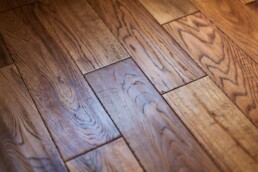Best Hardwood Species for Ontario Homes
Hardwood flooring adds warmth, elegance, and long-term value to any home. For Ontario homeowners, selecting the right hardwood species is crucial to withstand seasonal temperature changes, humidity, and daily wear. Here’s a guide to the best hardwood flooring options for Ontario homes.
1. Maple Hardwood Flooring
-
Durability: Maple is a hard, dense wood, ideal for high-traffic areas.
-
Aesthetic: Light tones provide a bright, contemporary look for Ontario homes.
-
Climate Performance: Maple handles Ontario’s cold winters and humid summers better than softer woods.
2. Oak Hardwood Flooring
-
Durability: Oak is one of the most durable hardwoods, resistant to dents and scratches.
-
Aesthetic: Classic grain patterns complement both traditional and modern Ontario interiors.
-
Versatility: Stains easily to match any décor style.
3. Hickory Hardwood Flooring
-
Durability: Extremely hard and shock-resistant.
-
Aesthetic: Strong grain patterns give a rustic, natural feel.
-
Best Use: Ideal for open-concept Ontario homes or homes with pets.
4. Engineered Hardwood Flooring
-
Construction: A hardwood veneer over a plywood base.
-
Climate Advantage: Handles Ontario’s seasonal humidity swings better than solid hardwood.
-
Variety: Available in many species, colors, and finishes.
Tips for Maintaining Hardwood in Ontario
-
Keep indoor humidity levels consistent to prevent warping.
-
Use protective mats near entrances to reduce salt and water damage in winter.
-
Schedule annual refinishing for long-term durability.
Choosing the right hardwood species for your Ontario home ensures beauty, durability, and comfort. Maple, oak, and hickory are excellent options, while engineered hardwood provides an added layer of protection against climate changes. Invest wisely, and your floors will last for decades.
Why LVP is a Smart Choice in Ontario
In Ontario, homeowners are increasingly seeking flooring solutions that combine style, durability, and sustainability. Luxury Vinyl Plank (LVP) has quickly become a top choice for eco-conscious families. Not only does it mimic the look of hardwood or stone, but it also offers environmental benefits and practical advantages for Canadian homes.
Why LVP is Eco-Friendly
-
Recycled Materials: Many LVP products use recycled vinyl or other sustainable components, reducing landfill waste.
-
Low VOC Emissions: LVP flooring emits fewer volatile organic compounds than traditional flooring, improving indoor air quality.
-
Durability Reduces Waste: LVP’s long lifespan means fewer replacements, conserving natural resources.
Advantages of LVP in Ontario Homes
-
Water-Resistant: Ontario’s winters and wet basements can wreak havoc on traditional wood floors, but LVP is waterproof and resilient.
-
Easy Maintenance: A simple mop and gentle cleaning solutions keep LVP looking new.
-
Cost-Effective: LVP often costs less than hardwood while providing a similar aesthetic.
Popular LVP Styles for Ontario Homes
-
Wood-Look Planks: Mimic oak, maple, or hickory without the high maintenance.
-
Stone and Tile Looks: Perfect for kitchens, bathrooms, and entryways.
-
Wide Planks: Offer a modern, spacious feel for open-concept Ontario homes.
Sustainable Local Options
Ontario homeowners can source LVP from local suppliers and showrooms, ensuring lower shipping footprints and supporting Canadian businesses. Brands such as [insert local brands] focus on sustainable practices and recycled materials.
Conclusion
Choosing LVP for your Ontario home is a smart move for both the environment and your wallet. With its eco-friendly materials, durability, and stylish designs, LVP is perfect for families looking for low-maintenance, high-quality flooring.
Luxury Vinyl Flooring: The Secret Star of Modern Home Design
Move Over Hardwood — There’s a New Star on the Floor
Luxury vinyl flooring (LVP and LVT) has gone from practical to posh. Once seen as a budget option, modern luxury vinyl is now one of the most sought-after materials in home design. Why? Because it gives homeowners the look of hardwood or stone — without the stress, cost, or maintenance.
The Secret Behind Its Popularity
1. It’s waterproof — yes, really
Perfect for kitchens, bathrooms, and basements, LVP and LVT can handle spills, humidity, and even pets without warping or staining.
2. Designer looks at a fraction of the cost
Luxury vinyl mimics natural materials with stunning realism. You can get the look of white oak, herringbone parquet, or even marble — for a fraction of the price.
3. Comfort underfoot
Unlike cold tile or rigid hardwood, vinyl flooring offers a slightly cushioned feel, making it comfortable for busy families who spend hours on their feet.
4. Installation made easy
Click-lock systems and glue-down options make luxury vinyl a dream for DIYers and pros alike.
Trending Looks for 2025
-
Rustic oak and coastal driftwood tones for a relaxed, natural feel.
-
Marble and terrazzo-look vinyl tiles for chic, modern spaces.
-
Wide-plank LVP that perfectly imitates European white oak flooring.
Hardwood Look, Stress-Free Lifestyle
Luxury vinyl flooring proves you don’t have to sacrifice beauty for durability. It’s waterproof, pet-proof, and life-proof — making it a smart choice for today’s homes that need to handle everything from spills to style statements.
Whether you’re designing a cozy basement retreat or a high-traffic kitchen, luxury vinyl might just be the secret star your home has been waiting for.
The Comeback Kid: Why Hardwood Flooring Is Still the Gold Standard in 2025
The Comeback Kid of Home Design
In a world obsessed with the new and next, hardwood flooring is the rare classic that keeps reinventing itself. From mid-century homes to modern condos, hardwood has remained the gold standard for warmth, beauty, and lasting value. But in 2025, this timeless favorite is getting a fresh glow-up — and homeowners are taking notice.
Why Hardwood Flooring Never Goes Out of Style
1. It ages like fine wine
Real hardwood develops character over time. Those subtle color shifts and gentle wear patterns? That’s called patina — and it’s one reason hardwood adds both charm and resale value to your home.
2. Engineered hardwood has changed the game
Modern engineered hardwood floors offer the same visual appeal as solid wood but with improved stability. They handle humidity, radiant heating, and basement installations better than ever before.
3. Sustainability is in style
Eco-conscious homeowners love that many flooring brands now source wood from responsibly managed forests. Plus, a well-maintained hardwood floor can last 100 years or more — the ultimate sustainable choice.
4. Refinish, don’t replace
Unlike vinyl or laminate, hardwood can be refinished multiple times, making it a smart long-term investment.
The 2025 Hardwood Trends to Watch
-
Warm neutrals like honey oak and natural maple are replacing the cool gray tones of the 2010s.
-
Wide planks are in — they make rooms feel bigger and more luxurious.
-
Matte finishes and low-gloss sheens are the go-to for that organic, “lived-in luxury” vibe.
Final Thoughts
Trends may come and go, but hardwood flooring’s beauty and resilience have stood the test of time. Whether you’re renovating a heritage home or designing a minimalist modern space, hardwood flooring remains the comeback kid that never really left.
Why Winter Is Hard on Hardwood Floors
Hardwood floors bring timeless beauty to a home, but they’re especially vulnerable during the winter season. Cold air, low humidity, and melting snow can all cause problems. Without preparation, you may notice gaps, scratches, or stains. Luckily, a few seasonal habits will keep your hardwood floors strong and stunning.
1. Manage Indoor Humidity
Wood expands in humidity and contracts when air is dry. In the winter, indoor air can dip below 30% humidity, causing boards to shrink and crack. Use a humidifier to maintain levels between 35–55%. This balance helps your hardwood remain stable and prevents gaps from forming.
2. Protect Against Water, Salt, and Slush
Snow and ice melt carried inside on boots can stain or warp hardwood. Place thick entry mats at every doorway, and add a boot tray for wet shoes. Wipe up puddles immediately before moisture seeps into seams. Salt crystals can scratch finishes, so frequent cleaning is essential.
3. Adjust Heating Practices
Direct heat from vents or space heaters can dry out wood faster. Redirect airflow away from your floors or use vent deflectors to keep warm air circulating evenly without damaging your hardwood.
4. Use Rugs and Runners Wisely
Area rugs in high-traffic spaces like hallways, mudrooms, and kitchens protect against heavy wear. Choose breathable pads under rugs so moisture isn’t trapped against your floors.
5. Clean With Care
Sweep or vacuum daily with a soft-brush attachment to capture salt and grit. For deeper cleaning, use a hardwood-specific cleaner—never steam mops or excessive water, which can cause permanent damage.
Bottom Line: With humidity control, moisture prevention, and proper cleaning, you can protect your hardwood floors through the winter months and enjoy their natural beauty year-round.
Winter-Proofing Your LVP Flooring: Tips for a Season of Comfort and Care
When the cold weather rolls in, your flooring often takes on more stress than any other surface in the home. Luxury Vinyl Plank (LVP) flooring is well known for being durable, stylish, and low-maintenance—but winter introduces unique challenges you’ll want to prepare for.
1. Control Moisture at the Door
Winter means snow, slush, and salt coming in on boots. Place high-quality entry mats both outside and inside your doors to catch excess moisture and grit before it reaches your LVP floors.
2. Wipe Up Spills Promptly
While LVP is water-resistant, standing water or melted ice can still seep into seams or cause slippery spots. Make it a habit to wipe up puddles quickly.
3. Keep Temperatures Consistent
Extreme cold or sudden heating can cause minor expansion or contraction of flooring. Keep your home’s thermostat steady—ideally between 65–75°F—to reduce unnecessary stress on your floors.
4. Use Felt Pads and Rugs
Winter means heavier traffic indoors. Protect your LVP from scratches caused by moving furniture or boots with grit by adding felt pads under chairs and placing rugs in high-traffic zones.
5. Gentle Cleaning Routine
Avoid harsh chemical cleaners often used to cut through winter salt. Instead, sweep regularly and use a pH-neutral vinyl floor cleaner to keep your LVP shining.
Bottom Line: With just a few preventative steps, your LVP flooring will handle winter with ease—leaving you with a warm, inviting space all season long.
Why LVP is the Best Flooring Choice for Fall and Winter Homes
As the seasons shift and colder weather approaches, homeowners begin preparing their homes for increased indoor activity, wet shoes, and heavy foot traffic. Flooring is one of the most impacted areas during fall and winter, making it essential to choose a material that can withstand seasonal challenges. Luxury Vinyl Plank, or LVP flooring, has become one of the most popular options for homeowners, offering durability, style, and practicality that fits perfectly with fall and winter living.
Durability in Harsh Conditions
Fall and winter bring rain, snow, and salt, all of which can cause significant damage to traditional hardwood or laminate. LVP flooring is designed to be waterproof and resistant to scratches, dents, and stains. This makes it an ideal choice for entryways, kitchens, and living spaces where seasonal messes are most common.
Easy Maintenance During Busy Seasons
With the holidays approaching, homeowners often look for ways to simplify cleaning. LVP flooring requires minimal upkeep compared to other flooring options. Simple sweeping and occasional mopping are usually enough to keep floors looking new, even when guests, kids, or pets track in dirt and debris from outside.
Warm and Stylish Appearance
One of the biggest draws of LVP flooring is its ability to replicate the warm, natural look of hardwood without the high cost or maintenance. In the fall and winter months, when creating a cozy and inviting home is a priority, LVP adds warmth and character to any room. With a wide range of colors and textures, it complements seasonal décor and provides timeless appeal.
Budget-Friendly for Seasonal Renovations
Fall is a popular time for home improvement projects as families prepare for the holidays and colder months ahead. LVP flooring is cost-effective, offering premium style at a fraction of the price of hardwood. Its affordability makes it possible for homeowners to renovate multiple rooms without exceeding their budget.
Comfort Underfoot
During colder seasons, flooring comfort matters more than ever. Many LVP flooring options are designed with added cushioning or can be installed with underlayment for improved insulation and warmth. This creates a comfortable surface underfoot, which is especially welcome in the colder months when families spend more time indoors.
Conclusion
When it comes to preparing your home for fall and winter, choosing the right flooring is key. LVP flooring provides the perfect balance of durability, low maintenance, style, and affordability. Whether you are looking to update your entryway, refresh your living room, or prepare your home for holiday gatherings, LVP flooring is one of the best investments you can make this season.
Fall Checklist: Protecting Your Hardwood Floors Before Winter
As the crisp fall air rolls in and the leaves start to turn, homeowners know one thing for certain—winter is coming. For those with hardwood flooring, the transition between seasons can take a toll if proper care isn’t taken. Between shifting humidity levels, wet boots, and road salt, hardwood floors face unique challenges this time of year.
The good news? With a few preventative steps, you can keep your hardwood floors looking stunning all season long. Here’s your fall checklist for protecting hardwood flooring before winter:
1. Control Indoor Humidity
Hardwood is a natural material that expands and contracts with changes in moisture. As the air dries out in fall and winter, floors can shrink, causing gaps between planks.
-
Aim to keep indoor humidity between 35–55%.
-
Use a humidifier once the furnace is running regularly.
-
Avoid drastic swings in temperature inside your home.
By maintaining steady conditions, you’ll extend the life and beauty of your hardwood flooring.
2. Protect Entryways from Moisture and Dirt
Autumn rains and winter snow bring water, mud, and debris indoors. All of these can dull or damage your hardwood floors.
-
Place high-quality floor mats at every entry.
-
Use boot trays to catch dripping shoes.
-
Sweep or vacuum regularly to prevent dirt and salt from scratching the surface.
Simple prevention at entryways is one of the most effective ways to protect hardwood flooring.
3. Check for Drafts and Seal Gaps
Cold drafts don’t just increase heating bills—they also dry out hardwood floors. Take time this fall to:
-
Seal any gaps around doors and windows.
-
Check baseboards for leaks where cold air can seep in.
-
Consider adding weather stripping to entry doors.
A tighter home helps regulate conditions for your hardwood flooring.
4. Refresh Your Finish
If your floors are looking dull, fall is the perfect time to give them new life before the heavy wear-and-tear of winter.
-
Use a hardwood flooring cleaner—never water and vinegar.
-
Apply a maintenance coat or polish if your finish is wearing thin.
-
For deep scratches or damage, consider scheduling a professional refinish.
A little care now prevents costly repairs later.
5. Use Rugs in High-Traffic Areas
Holiday gatherings and fall entertaining mean more foot traffic. Protect your floors by:
-
Laying down area rugs in dining rooms, hallways, and living rooms.
-
Choosing rugs with breathable pads designed for hardwood flooring.
-
Rotating rugs occasionally to ensure even wear.
Not only do rugs add warmth and style, but they also shield your hardwood floors from scratches and scuffs.
6. Schedule a Professional Inspection
If your hardwood floors are older, now is the time to bring in a professional. A flooring expert can:
-
Check for warping, loose planks, or finish issues.
-
Recommend seasonal maintenance.
-
Ensure your hardwood flooring is ready for the months ahead.
Final Thoughts
Your hardwood flooring is one of the most beautiful features of your home and one of the biggest investments. By following this fall maintenance checklist, you’ll protect your floors from seasonal damage and keep them looking their best through the holidays and beyond.
Whether you need a professional cleaning, refinishing, or even new hardwood installation, fall is the perfect time to act. Don’t wait until winter damage sets in—start protecting your floors today.
Can You Install LVP Over Tile or Concrete? Here’s What You Need to Know
Luxury Vinyl Plank (LVP) flooring has quickly become one of the most popular choices for homeowners and renovators thanks to its durability, waterproof features, and easy installation. But one of the most common questions people ask before purchasing is:
Can you install LVP over existing tile or concrete?
The short answer is: Yes, you can — but there are a few important things you need to know before starting.
In this guide, we’ll cover:
-
Whether LVP can be installed over tile or concrete
-
What conditions must be met
-
Pros and cons of doing so
-
Step-by-step preparation tips
-
When to consider removing your old floor first
Can You Install LVP Over Tile?
Yes, LVP can be installed directly over ceramic or porcelain tile — as long as the tile is in good condition.
Requirements:
-
The tiles must be level and securely fixed (no loose tiles)
-
Grout lines should be no deeper than 1/8 inch
-
The floor must be clean, dry, and free of debris
Tips:
-
Use a self-leveling compound to fill deep grout lines or uneven areas
-
A thin underlayment can help with minor imperfections and soundproofing
Important: If your tile is uneven or cracked, those flaws can telegraph through the LVP over time.
Can You Install LVP Over Concrete?
Yes, LVP is one of the best flooring types for concrete subfloors, especially in basements or slab-on-grade homes.
Requirements:
-
Concrete must be fully cured, level, and moisture-tested
-
Surface must be free of cracks, adhesives, or residue
-
Moisture content should meet manufacturer guidelines (often ≤ 75% RH)
Tips:
-
Use a vapor barrier under your LVP to prevent moisture damage
-
Consider applying a concrete sealer if moisture is a concern
-
For older concrete, repair cracks or use a patching compound
Floating vs Glue-Down Installation
The method you use can affect whether tile or concrete is a good base.
| Method | Works Over Tile? | Works Over Concrete? | Notes |
|---|---|---|---|
| Floating (Click-Lock) | Yes | Yes | Most DIY-friendly option |
| Glue-Down | Not ideal | Yes (if porous) | Requires smooth, absorbent surface |
If you plan to float your LVP, a smooth and stable base is crucial. If glue-down is preferred, ensure the surface can accept adhesive.
Pros of Installing LVP Over Existing Floors
-
Saves Time and Money: No need to rip up old tile or prep raw concrete
-
Less Mess: Avoids demolition, especially with dusty tile tear-outs
-
Adds Insulation: Existing tile or concrete can help with thermal insulation
-
Faster Turnaround: Especially useful in rentals or tight timelines
Cons and Risks to Consider
-
Increased Floor Height: May affect door clearance, trim, or transitions
-
Subfloor Imperfections Show: Any unevenness will show over time if not corrected
-
Possible Moisture Issues: Especially with concrete or if installing in a basement
-
Warranty Concerns: Not following manufacturer prep guidelines could void warranty
How to Prepare Your Floor for Luxury Vinyl Flooring Installation
Step-by-step guide:
-
Inspect the surface
Check for cracks, loose tiles, moisture, or uneven spots. -
Clean thoroughly
Vacuum and wash the floor to remove dust, grease, or adhesives. -
Level and patch
Use a self-leveling compound or patching mix where needed. -
Test for moisture (concrete only)
Use a calcium chloride or RH test to confirm acceptable levels. -
Install underlayment (if required)
Depending on your LVP and subfloor, use an appropriate underlayment or vapor barrier. -
Acclimate your flooring
Let Luxury Vinyl Flooring planks sit in the room for 48 hours to adjust to temperature and humidity. -
Begin your installation
Follow manufacturer guidelines based on click-lock or glue-down method.
When Should You Remove the Old Floor Instead?
You should consider removing tile or prepping concrete more aggressively if:
-
Tiles are cracked, loose, or unlevel
-
The subfloor is extremely uneven
-
Moisture levels are too high
-
You’re installing a glue-down Luxury Vinyl Flooring that requires a flat, porous surface
Final Thoughts
Installing LVP over tile or concrete is not only possible, but it's also one of the most efficient ways to upgrade your flooring without the hassle of full demolition. With proper preparation, you can achieve a beautiful, durable, and cost-effective result that will last for years.
If you’re unsure about the condition of your existing floor or want help selecting the right Luxury Vinyl Flooring for your subfloor type, consult a flooring expert before you begin.
Need Help With Your Luxury Vinyl Flooring Project?
We offer free in-home consultations and expert advice on Luxury Vinyl Flooring installation over tile or concrete. Our team can assess your floor and help you choose the perfect plank for your space and budget.
Contact us today or stop by our showroom to explore the latest styles and installation options.
Hardwood Floors Stains: How to Pick the Perfect Tone for Your Space
When it comes to designing your dream home, few decisions have as much visual impact as the color of your hardwood floors. The right stain can dramatically transform a room — adding warmth, sophistication, or a sleek modern vibe. But with so many options available, how do you pick the perfect hardwood floor stain for your space?
In this guide, we’ll walk you through:
-
Popular stain color categories
-
Factors to consider when choosing a stain
-
Room-by-room suggestions
-
Pro tips for testing before you commit
Whether you're refinishing existing hardwood or installing new flooring, these insights will help you choose the best stain color to complement your home.
Popular Hardwood Floors Stain Colors
1. Natural and Clear Finishes
-
Look: Light, raw, and minimal
-
Best for: Small rooms or Scandinavian-style interiors
-
Works well on: White oak, maple
-
Pairs with: White walls, soft neutrals, light furniture
2. Warm Honey and Golden Tones
-
Look: Classic and cozy with a golden glow
-
Best for: Traditional, farmhouse, or rustic styles
-
Works well on: Red oak, pine
-
Pairs with: Earth tones, beige, and antique decor
3. Medium Browns
-
Look: Timeless and versatile with a rich undertone
-
Best for: Open-concept or transitional spaces
-
Works well on: Walnut, white oak
-
Popular stains: Provincial, Early American, Special Walnut
4. Dark Espresso and Mocha Tones
-
Look: Elegant and dramatic
-
Best for: Large spaces or contemporary styles
-
Caution: Can show dust, scratches, and pet hair
-
Pairs with: Bright whites, bold color schemes
5. Gray and Greige Tones
-
Look: Cool, modern, and urban
-
Best for: Coastal homes, modern condos, or lofts
-
Popular stains: Classic Gray, Weathered Oak
-
Works best on: White oak for an even finish
6. Custom and Mixed Stains
-
Look: Tailored and unique
-
Best for: Homeowners seeking a one-of-a-kind look
-
Note: Often involves blending multiple stains or water-popping techniques
How to Choose the Right Hardwood Floors Stain
Choosing a hardwood stain is about more than color preference — it’s about how the tone fits your space, lifestyle, and design goals. Consider the following:
1. Room Size and Natural Light
-
Light stains help small rooms feel larger and brighter
-
Dark stains add contrast but may make a space feel smaller
-
Use mid-tones to balance bright light or high ceilings
2. Wall Colors and Interior Design Style
-
Warm-toned stains pair well with creams, browns, and traditional décor
-
Cool-toned stains match modern, industrial, or coastal styles
-
Neutral stains allow flexibility if you change décor frequently
3. Wood Species
-
Different woods absorb stains differently
-
Red oak may pull red or pink tones
-
White oak offers a more neutral base for gray or cool tones
-
Maple and birch may absorb stain unevenly
4. Lifestyle and Maintenance
-
Dark stains tend to highlight scratches, dust, and pet hair
-
Lighter stains are generally easier to maintain
-
Matte finishes are more forgiving than glossy ones
Always Test Before You Stain
Never rely solely on sample boards or online images. Always test stains on your actual wood floor. Here's why:
-
Your wood’s grain, age, and type all affect stain absorption
-
Apply three to four test swatches in an inconspicuous area
-
View the samples in different lighting conditions throughout the day
-
Let the stain fully dry to see its final appearance
Tip: Water-popping the wood (applying water before staining) can intensify the color but will also make the wood more absorbent — test accordingly.
Room-by-Room Hardwood Floors Stain Suggestions
| Room | Recommended Stain Tone | Reason |
|---|---|---|
| Living Room | Medium or dark brown | Warm, inviting atmosphere |
| Kitchen | Natural or light brown | Bright, clean look; hides crumbs |
| Bedroom | Warm honey or greige | Calming, restful tone |
| Hallways | Light to medium tone | Conceals dirt and scuffs well |
| Basement | Mid-tone or gray (engineered) | Enhances low-light areas with a modern feel |
Final Thoughts: Matching Your Floors to Your Life
Your hardwood floor stain sets the tone for your entire space. Choosing the right color depends on more than just current trends — it's about how the tone complements your home’s lighting, layout, existing design, and how you live day to day.
By understanding the stain options and testing carefully, you’ll be able to achieve a look that enhances both the style and function of your space for years to come.
Need Help Choosing the Perfect Stain?
Our flooring experts offer personalized consultations and in-home sampling to help you find the ideal stain for your hardwood floors. Contact us today to schedule a visit or stop by our showroom.


